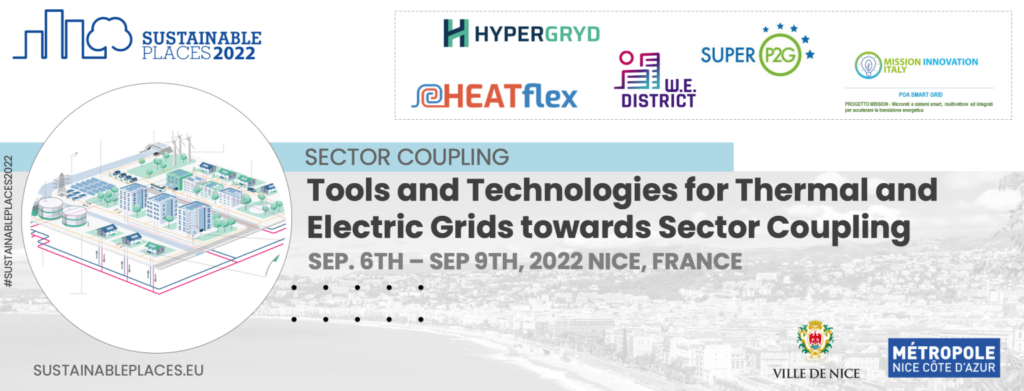The workshop: Tools and Technologies for Thermal and Electric Grids towards Sector Coupling will take place the September 8th (16:00-17:30 CEST) at the Université Côte d’Azur, Campus Saint-Jean d’Angély, Nice, France, Room 1 1A36.

Five European projects (HYPERGRYD, HEATflex, MISSION, SUPERP2G, and WEDISTRICT) will discuss, with the chair of the session (Valeria Palomba, CNR ITAE), the synergies and lessons learned regarding the coupling of the hybrid thermal and grid sectors.
The Danish/Austrian HEATflex project objective is to develop a common technical and economic strategy to increase the use of waste heat and the competitiveness of CHP. One of the perspectives is to bring flexibility to heat in district heating networks. The project aims to investigate how heat can be recovered from other processes (e.g., industry, data centers, cogeneration with cooling, excess energy). Two user-friendly decision support tools have been developed to look at the effects on RES integration, e.g., with sector coupling via heat pumps, or the use of waste heat. Three roadmaps will bring DH grid operators, planners, and CHP plants the innovative possibility to check the technical and economic feasibility using simple input data.
The WEDISTRICT project is born to demonstrate 100% fossil fuel-free heating and cooling solutions by optimally integrating multiple renewable energy sources and waste heat in new and existing DHC systems. To this end, the integration of nine enhanced renewable solutions for DHC generation in real DHC sites will be carried out within the project.
The Multi-vector Integrated Smart Systems and Intelligent microgrids for accelerating the energy transition (MISSION) project aims at developing two Smart Grid demonstrators – microgrid-sized and near full-scale – located, respectively, at CRENEA in Portici (Smart Energy Microgrid ENEA) and the CSR offices in Milan and Piacenza, focusing on the design and implementation of technological solutions that enable the transition of grids towards integrated and intelligent multi-energy distribution systems.
SuperP2G interconnects the main P2G initiatives in five countries, ensuring joint learning within 3 years (2019-2022). Each national project focuses on different challenges, where researchers partner with local need owners to co-create solutions. SuperP2G focuses on improving existing tools, including open access, as well as developing a new open tool based on the OptiFlow and H2IndexII tools. This work is complemented by regulatory and market analysis as well as stakeholder involvement.
HYPERGRYD aims to develop a set of cost-effective, replicable, and scalable technical solutions that enable the integration of RES with different partitioning and intrinsic variability within thermal grids, as well as their linkage with electricity grids. The project includes the development of innovative key components, in parallel with innovative and integrated ICT services for the proper handling of the increasing complexity of the systems (from the building to the Local Energy Community (LEC) levels), to accelerate the sustainable transformation, planning, and modernization of District Heating and Cooling (DHC) towards 4th and 5th generation.
Don’t miss it!
Visit the Sustainable Places 2022 website to know more about the event: Home – Sustainable Places (SP)